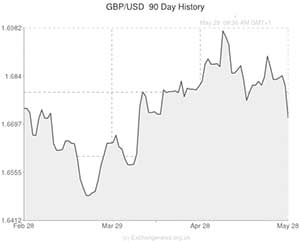
The Pound to US Dollar exchange rate (GBP/USD) remained fairly flat yesterday, trading in the region of 1.6715 despite the fact that US Gross Domestic Product was revised down from +0.1% to -1.0%.
Analysts were primed for a downgrade to -0.5% but the actual result showed a contraction of twice that amount during the first quarter. Icy storms and extreme weather conditions were blamed for the soft print as exports, business investment, inventories and corporate profits all plummeted at the start of the year.
The fact that GBP/USD failed to spike following the release of such a brittle GDP report suggests that Sterling may find it difficult to make further gains versus the US Dollar.
The Pound has depreciated by around three cents since the start of May when GBP/USD failed to breach longstanding technical resistance at 1.7000. Bank of England rate hike bets were softened earlier in the week when UK mortgage approval data weakened and CBI retail sales figures cooled from the previous month.
This leaves Sterling susceptible to further depreciation in the near-term as the GBP to USD bull-run comes to an end.
A separate report yesterday showed that US initial jobless claims fell by -27,000 to 300,000 last week, which bodes well for future growth in the world’s largest economy.
Markets are anticipating a strong rebound in the second quarter of the year as the US economy breaks free from the shackles of Q1. The latest PMI report from Markit Economics suggests that private sector output across the United States is currently rising at its fastest pace for over four years. When analysing the correlation between composite PMI and US GDP it appears possible that economic growth could print as high as 4.5% for the second quarter.
With Bank of England rate hike bets already priced into the currency market and US growth prospects improving it seems as though Sterling may track back down beyond 1.6600 over the coming weeks and months.
If GBP/USD falls below psychological support at 1.6600 then there is little, technically speaking, which would stop Sterling sliding all the way to 1.6300.
If the Pound is to remain close to its current 4.5-year highs against the ‘Greenback’ then fresh British data will have to impress BoE policymakers to the extent that they start to consider raising interest rates before the year is out. For this to happen we will need to see incontrovertible evidence that productivity in the UK labour market is improving rapidly. If the unemployment rate continues to fall and full-time employment surges then it is possible that GBP/USD’s bullish run could continue.

Comments are closed.